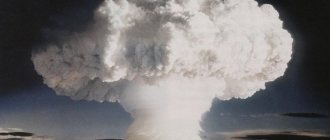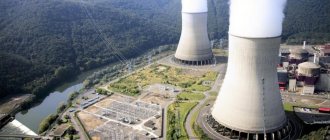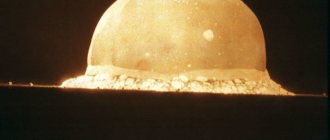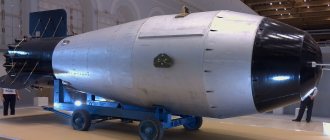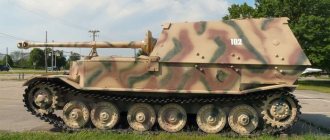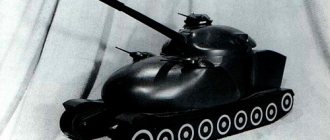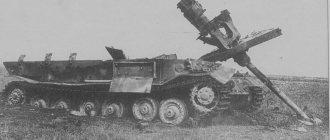At the beginning of the 20th century, thanks to the efforts of Albert Einstein, humanity first learned that, at the atomic level, a huge amount of energy can be obtained from a small amount of matter under certain conditions. In the 1930s, work in this direction was continued by the German nuclear physicist Otto Hahn, the Englishman Robert Frisch and the Frenchman Joliot-Curie. It was they who managed to trace in practice the results of the fission of the nuclei of atoms of radioactive chemical elements. The chain reaction process simulated in laboratories confirmed Einstein’s theory about the ability of a substance in small quantities to release large amounts of energy. In such conditions, the physics of a nuclear explosion was born - a science that cast doubt on the possibility of the further existence of earthly civilization.
The Birth of Nuclear Weapons
Back in 1939, the Frenchman Joliot-Curie realized that exposure to uranium nuclei under certain conditions could lead to an explosive reaction of enormous power. As a result of a nuclear chain reaction, spontaneous exponential fission of uranium nuclei begins and a huge amount of energy is released. In an instant, the radioactive substance exploded, and the resulting explosion had a huge damaging effect. As a result of the experiments, it became clear that uranium (U235) can be converted from a chemical element into a powerful explosive.
For peaceful purposes, when a nuclear reactor is operating, the process of nuclear fission of radioactive components is calm and controlled. In a nuclear explosion, the main difference is that a colossal amount of energy is released instantly and this continues until the supply of radioactive explosives runs out. The first time a person learned about the combat capabilities of the new explosive was on July 16, 1945. While the final meeting of the Heads of State of the victors of the war with Germany was taking place in Potsdam, the first test of an atomic warhead took place at the Alamogordo test site in New Mexico. The parameters of the first nuclear explosion were quite modest. The power of the atomic charge in TNT equivalent was equal to the mass of trinitrotoluene of 21 kilotons, but the force of the explosion and its impact on surrounding objects made an indelible impression on everyone who observed the tests.
Underground testing
Recently, there has been an agreement between countries that regulates nuclear tests and prescribes that they be carried out only underground, which helps to minimize pollution and uninhabitable areas formed around test sites.
Tests underground are considered the least dangerous, since all damaging factors affect the rocks. It is impossible to see luminous flashes or a mushroom cloud; all that remains is a column of dust. But the shock wave leads to an earthquake and soil collapse. This is usually used for peaceful purposes, to solve economic problems. For example, this can be used to destroy mountain ranges or create artificial reservoirs.
Explosion of the first atomic bomb
First, everyone saw a bright luminous point, which was visible at a distance of 290 km. from the testing site. At the same time, the sound of the explosion was heard within a radius of 160 km. A huge crater formed at the site where the nuclear explosive device was installed. The crater from the nuclear explosion reached a depth of more than 20 meters, having an outer diameter of 70 m. In the territory of the test site, within a radius of 300-400 meters from the epicenter, the surface of the earth was a lifeless lunar surface.
It is interesting to cite the recorded impressions of participants in the first atomic bomb test. “The surrounding air became denser, and its temperature instantly rose. Literally a minute later, a huge shock wave swept across the area. A huge fireball forms at the point where the charge is located, after which a mushroom-shaped cloud of nuclear explosion begins to form in its place. A column of smoke and dust, topped with a massive nuclear mushroom head, rose to a height of 12 km. Everyone present in the shelter was amazed by the scale of the explosion. No one could imagine the power and strength we faced,” Leslie Groves, the head of the Manhattan Project, subsequently wrote.
No one before or since had such enormous power at their disposal. This is despite the fact that at that time scientists and the military did not yet have an idea of all the damaging factors of the new weapon. Only the visible main damaging factors of a nuclear explosion were taken into account, such as:
- shock wave of a nuclear explosion;
- light and thermal radiation from a nuclear explosion.
At that time, they did not yet have a clear idea that penetrating radiation and subsequent radioactive contamination during a nuclear explosion are deadly for all living things. It turned out that these two factors after a nuclear explosion will subsequently become the most dangerous for humans. The zone of complete destruction and devastation is quite small in area compared to the zone of contamination of the area with radiation decay products. The contaminated area may cover hundreds of kilometers. To the exposure received in the first minutes after the explosion, and to the level of radiation subsequently added to the contamination of large areas by radiation fallout. The scale of the disaster is becoming apocalyptic.
Only later, much later, when atomic bombs were used for military purposes, it became clear how powerful the new weapon was and how severe the consequences of using a nuclear bomb would be for people.
Ground tests
The first bombs were tested directly on the surface of the earth. It is these types of explosions that are accompanied by a clearly defined mushroom cloud in the air and a crater extending over several tens or even hundreds of meters in the soil. A ground explosion looks the most frightening, since the cloud, hovering low above the ground, attracts not only dust, but also a significant part of the soil, which makes it almost black. Soil particles are mixed with chemical elements and then fall to the ground, which makes the area radioactively contaminated and completely uninhabitable. For military purposes, this can be used to destroy powerful buildings or objects and infect large areas. The destructive effect is the most powerful.
The mechanism of atomic charge and principle of operation
Without going into detailed descriptions and technology for creating an atomic bomb, a nuclear charge can be briefly described in literally three phrases:
- there is a subcritical mass of radioactive substance (uranium U235 or plutonium Pu239);
- creation of certain conditions for the start of a chain reaction of fission of nuclei of radioactive elements (detonation);
- creation of a critical mass of fissile material.
The entire mechanism can be depicted in a simple and understandable drawing, where all the parts and details are in strong and close interaction with each other. As a result of the detonation of a chemical or electrical detonator, a detonation spherical wave is launched, compressing the fissile substance to a critical mass. The nuclear charge is a multilayer structure. Uranium or plutonium is used as the main explosive. The detonator can be a certain amount of TNT or hexogen. Further, the compression process becomes uncontrollable.
The speed of the processes is enormous and comparable to the speed of light. The time interval from the start of detonation to the start of an irreversible chain reaction takes no more than 10-8 s. In other words, it takes only 10-7 seconds to power 1 kg of enriched uranium. This value indicates the time of a nuclear explosion. The reaction of thermonuclear fusion, which is the basis of a thermonuclear bomb, proceeds at a similar speed with the difference that the nuclear charge activates an even more powerful one - a thermonuclear charge. The thermonuclear bomb has a different operating principle. Here we are dealing with the reaction of synthesis of light elements into heavier ones, as a result of which again a huge amount of energy is released.
During the fission process of uranium or plutonium nuclei, a huge amount of energy is created. At the center of a nuclear explosion the temperature is 107 Kelvin. In such conditions, colossal pressure arises - 1000 atm. Atoms of the fissile substance turn into plasma, which becomes the main result of the chain reaction. During the accident at the 4th reactor of the Chernobyl nuclear power plant there was no nuclear explosion, since the fission of radioactive fuel was carried out slowly and was accompanied only by intense heat release.
The high speed of processes occurring inside the charge leads to a rapid jump in temperature and an increase in pressure. It is these components that form the nature, factors and power of a nuclear explosion.
Four degrees of radiation sickness
Depending on the absorbed dose, four degrees of radiation sickness are distinguished.
Radiation sickness of the 1st degree (mild) occurs with a total radiation dose of 100-200 rad. The latent period lasts 2-3 weeks, after which malaise, general weakness, nausea, dizziness, and periodic increases in body temperature appear. The content of red blood cells in the blood decreases.
Radiation sickness of the second degree (moderate) occurs with a total radiation dose of 200-400 rad. The latent period lasts about a week. Symptoms of the disease are more pronounced. With active treatment, recovery occurs in 1.5-2 months.
Radiation sickness of the third degree (severe) occurs at a radiation dose of 400-600 rad. The latent period is several hours. The disease is severe and severe. With intensive treatment, recovery is possible in 6-8 months.
Radiation sickness IV degree (extremely severe form) occurs with a radiation dose of more than 600 rad. The disease is accompanied by darkening of consciousness, increased body temperature, impaired water-salt balance and ends in death after 5-10 days.
Animal radiation sickness occurs at higher doses of radiation.
At high doses of radiation, radio electronics, electrical automation and communications equipment fail.
Various materials that attenuate gamma rays and neutrons serve as protection against penetrating radiation.
Types and types of nuclear explosions
The chain reaction that has been started can no longer be stopped. In thousandths of a second, a nuclear charge consisting of radioactive elements turns into a plasma clot, torn apart by high pressure. A sequential chain of a number of other factors begins that have a damaging effect on the environment, infrastructure and living organisms. The difference in damage caused is only that a small nuclear bomb (10-30 kilotons) entails a smaller scale of destruction and less severe consequences than a large nuclear explosion with a power of 100 megatons or more brings.
The damaging factors depend not only on the power of the charge. To assess the consequences, the conditions for detonating a nuclear weapon, and what type of nuclear explosion is observed in this case, are important. Detonation of a charge can be carried out on the surface of the earth, underground or under water, according to the conditions of use we are dealing with the following types:
- aerial nuclear explosions carried out at certain heights above the earth's surface;
- high-altitude explosions carried out in the planet’s atmosphere at altitudes above 10 km;
- ground (surface) nuclear explosions carried out directly above the surface of the earth or above the surface of the water;
- underground or underwater explosions carried out in the surface layer of the earth's crust or under water at a certain depth.
In each individual case, certain damaging factors have their own strength, intensity and characteristics of action, leading to certain results. In one case, a targeted destruction of a target occurs with minimal destruction and radioactive contamination of the territory. In other cases, one has to deal with large-scale devastation of the area and destruction of objects, instantaneous destruction of all living things occurs, and severe radioactive contamination of vast areas is observed.
An airborne nuclear explosion, for example, differs from a ground-based detonation in that the fireball does not come into contact with the surface of the earth. In such an explosion, dust and other small fragments are combined into a dust column that exists separately from the explosion cloud. Accordingly, the area affected depends on the height of the detonation. Such explosions can be high or low.
The first tests of atomic warheads in both the USA and the USSR were mainly of three types: ground, air and underwater. Only after the Nuclear Test Limitation Treaty came into force did nuclear explosions in the USSR, the USA, France, China and Great Britain begin to be carried out only underground. This made it possible to minimize environmental pollution by radioactive products and reduce the area of exclusion zones that arose near military training grounds.
The most powerful nuclear explosion carried out in the entire history of nuclear testing took place on October 30, 1961 in the Soviet Union. The bomb, with a total weight of 26 tons and a yield of 53 megatons, was dropped in the area of the Novaya Zemlya archipelago from a Tu-95 strategic bomber. This is an example of a typical high air explosion, since the charge detonated at an altitude of 4 km.
It should be noted that the detonation of a nuclear warhead in the air is characterized by strong exposure to light radiation and penetrating radiation. The flash of a nuclear explosion is clearly visible tens and hundreds of kilometers from the epicenter. In addition to powerful light radiation and a strong shock wave spreading around 3600, the air explosion becomes a source of strong electromagnetic disturbance. An electromagnetic pulse generated during an airborne nuclear explosion within a radius of 100-500 km. capable of destroying all ground-based electrical infrastructure and electronics.
A striking example of a low air explosion was the atomic bombing of the Japanese cities of Hiroshima and Nagasaki in August 1945. The “Fat Man” and “Kid” bombs went off at an altitude of half a kilometer, thereby covering almost the entire territory of these cities with a nuclear explosion. Most of the residents of Hiroshima died in the first seconds after the explosion, as a result of exposure to intense light, heat and gamma radiation. The shock wave completely destroyed city buildings. In the case of the bombing of the city of Nagasaki, the effect of the explosion was weakened by the features of the relief. The hilly terrain allowed some areas of the city to avoid the direct impact of light rays and reduced the impact force of the blast wave. But during such an explosion, extensive radioactive contamination of the area was observed, which subsequently led to serious consequences for the population of the destroyed city.
Low and high air bursts are the most common modern weapons of mass destruction. Such charges are used to destroy concentrations of troops and equipment, cities and ground infrastructure.
A high-altitude nuclear explosion differs in its method of application and nature of action. A nuclear weapon is detonated at an altitude of more than 10 km, in the stratosphere. With such an explosion, a bright sun-shaped flare of large diameter is observed high in the sky. Instead of clouds of dust and smoke, a cloud soon forms at the site of the explosion, consisting of hydrogen, carbon dioxide and nitrogen molecules evaporated under the influence of high temperatures.
In this case, the main damaging factors are the shock wave, light radiation, penetrating radiation and EMR from a nuclear explosion. The higher the height of the charge detonation, the lower the force of the shock wave. Radiation and light emission, on the contrary, only intensify with increasing altitude. Due to the absence of significant movement of air masses at high altitudes, radioactive contamination of territories in this case is practically reduced to zero. Explosions at high altitudes made within the ionosphere disrupt the propagation of radio waves in the ultrasonic range.
Such explosions are mainly aimed at destroying high-flying targets. These could be reconnaissance aircraft, cruise missiles, strategic missile warheads, artificial satellites and other space attack weapons.
A ground-based nuclear explosion is a completely different phenomenon in military tactics and strategy. Here, a specific area of the earth's surface is directly affected. The detonation of a warhead can be carried out over an object or over water. The first tests of atomic weapons in the USA and the USSR took place in exactly this form.
A distinctive feature of this type of nuclear explosion is the presence of a pronounced mushroom cloud, which is formed due to the huge volumes of soil and rock particles raised by the explosion. At the very first moment, a luminous hemisphere is formed at the site of the explosion, its lower edge touching the surface of the earth. During a contact detonation, a crater is formed at the epicenter of the explosion, where the nuclear charge exploded. The depth and diameter of the crater depends on the power of the explosion itself. When using small tactical ammunition, the diameter of the crater can reach two to three tens of meters. When a nuclear bomb explodes with high power, the size of the crater often reaches hundreds of meters.
The presence of a powerful mud-dust cloud causes the bulk of the radioactive products of the explosion to fall back onto the surface, making it completely contaminated. Smaller dust particles enter the surface layer of the atmosphere and, together with air masses, are scattered over vast distances. If an atomic charge is detonated on the surface of the earth, the radioactive trace from the resulting ground explosion can stretch for hundreds and thousands of kilometers. During the accident at the Chernobyl nuclear power plant, radioactive particles that entered the atmosphere fell along with precipitation in the Scandinavian countries, which are located 1000 km from the site of the disaster.
Ground explosions can be carried out to destroy and destroy highly durable objects. Such explosions can also be used if the goal is to create a vast zone of radioactive contamination of the area. In this case, all five damaging factors of a nuclear explosion are in effect. Following the thermodynamic shock and light radiation, an electromagnetic pulse comes into play. The destruction of the object and manpower within the radius of action is completed by a shock wave and penetrating radiation. Last but not least is radioactive contamination. Unlike the ground-based detonation method, a surface nuclear explosion lifts huge masses of water into the air, both in liquid and vapor form. The destructive effect is achieved due to the impact of the air shock wave and the great excitement generated as a result of the explosion. Water raised into the air prevents the spread of light radiation and penetrating radiation. Due to the fact that water particles are much heavier and are a natural neutralizer of elemental activity, the intensity of the spread of radioactive particles in the airspace is insignificant.
An underground explosion of a nuclear weapon is carried out at a certain depth. Unlike ground explosions, there is no glowing area. The earth's rock takes on all the enormous force of the impact. The shock wave diverges through the earth, causing a local earthquake. The enormous pressure created during the explosion forms a column of soil collapse that goes to great depths. As a result of rock subsidence, a crater is formed at the explosion site, the dimensions of which depend on the power of the charge and the depth of the explosion.
Such an explosion is not accompanied by a mushroom cloud. The column of dust that rose at the site of the charge detonation is only a few tens of meters high. The shock wave, converted into seismic waves, and local surface radioactive contamination are the main damaging factors in such explosions. As a rule, this type of detonation of a nuclear charge has economic and practical significance. Today, most nuclear tests are carried out underground. In the 70-80s, national economic problems were solved in a similar way, using the colossal energy of a nuclear explosion to destroy mountain ranges and form artificial reservoirs.
On the map of nuclear test sites in Semipalatinsk (now the Republic of Kazakhstan) and in the state of Nevada (USA) there are a huge number of craters, traces of underground nuclear tests.
Underwater detonation of a nuclear charge is carried out at a given depth. In this case, there is no light flash during the explosion. On the surface of the water at the site of the explosion, a water column 200-500 meters high appears, which is crowned with a cloud of spray and steam. The formation of a shock wave occurs immediately after the explosion, causing disturbances in the water column. The main damaging factor of the explosion is the shock wave, which transforms into waves of great height. When high-power charges explode, the wave height can reach 100 meters or more. Subsequently, severe radioactive contamination was observed at the site of the explosion and in the surrounding area.
American experiments
The nuclear explosion in space, carried out by the Americans, by the way, more than once or twice, on the one hand, was of a scientific nature, on the other hand, it destroyed everything. After all, no one knew how the background radiation would behave after the explosion. Scientists could only speculate, but no one expected such shocking material that they eventually received. Below we will talk about the impact of a nuclear explosion in space on ordinary earthly life and their inhabitants.
The first and most famous was Operation Argus, carried out one September day in 1958. Moreover, the area for preparing the explosion of a nuclear bomb in space was selected very carefully.
Methods of protection against damaging factors of a nuclear explosion
As a result of the explosive reaction of a nuclear charge, a huge amount of thermal and light energy is generated, capable of not only destroying and destroying inanimate objects, but killing all living things over a large area. At the epicenter of the explosion and in the immediate vicinity of it, as a result of the intense impact of penetrating radiation, light, thermal radiation and shock waves, all living things die, military equipment is destroyed, buildings and structures are destroyed. With distance from the epicenter of the explosion and over time, the strength of the damaging factors decreases, giving way to the last destructive factor - radioactive contamination.
It is useless to seek salvation for those caught in the epicenter of a nuclear apocalypse. Neither a strong bomb shelter nor personal protective equipment will save you here. Injuries and burns received by a person in such situations are incompatible with life. The destruction of infrastructure facilities is total and cannot be restored. In turn, those who find themselves at a considerable distance from the explosion site can count on salvation using certain skills and special methods of protection.
The main damaging factor in a nuclear explosion is the shock wave. The high pressure region formed at the epicenter affects the air mass, creating a shock wave that spreads in all directions at supersonic speed.
The speed of propagation of the blast wave is as follows:
- on flat terrain, the shock wave travels 1000 meters from the epicenter of the explosion in 2 seconds;
- at a distance of 2000 m from the epicenter, the shock wave will overtake you in 5 seconds;
- being at a distance of 3 km from the explosion, the shock wave should be expected after 8 seconds.
After the blast wave passes, an area of low pressure appears. Trying to fill the rarefied space, the air flows in the opposite direction. The created vacuum effect causes another wave of destruction. Having seen the flash, you can try to find shelter before the blast wave arrives, reducing the effects of the shock wave.
Light and thermal radiation lose their power at a great distance from the epicenter of the explosion, so if a person managed to take cover at the sight of the flash, one can count on salvation. Much more dangerous is penetrating radiation, which is a rapid stream of gamma rays and neutrons that spread at the speed of light from the luminous area of the explosion. The most powerful impact of penetrating radiation occurs in the first seconds after the explosion. While in a shelter or shelter, there is a high probability of avoiding direct exposure to deadly gamma radiation. Penetrating radiation causes severe damage to living organisms, causing radiation sickness.
If all the previous listed damaging factors of a nuclear explosion are short-term in nature, then radioactive contamination is the most insidious and dangerous factor. Its destructive effect on the human body occurs gradually over time. The amount of residual radiation and the intensity of radioactive contamination depend on the power of the explosion, terrain conditions and climatic factors. The radioactive products of the explosion, mixing with dust, small fragments and fragments, enter the ground air layer, after which, together with precipitation or independently, they fall to the surface of the earth. The radiation background in the zone where nuclear weapons are used is hundreds of times higher than the natural radiation background, creating a threat to all living things. While in an area that has been subjected to a nuclear attack, you should avoid contact with any objects. Personal protective equipment and a dosimeter will reduce the likelihood of radioactive contamination.
Use for combat purposes
Hiroshima and Nagasaki are the only cities against which nuclear weapons were used. The tragedy that happened there was unparalleled.
Residents experienced the effects of an airborne nuclear explosion initiated at a short distance from the surface of the earth and classified as low. At the same time, the infrastructure was completely destroyed, about 200 thousand people died. Two thirds of them died instantly. Those who were at the epicenter disintegrated into molecules from the monstrous temperatures. The light radiation left shadows on the walls from them.
People who were further from the epicenter died from the shock wave and gamma radiation of the nuclear explosion. Some of the survivors received a lethal dose of radiation, but doctors did not yet know about radiation sickness, so no one understood why, after imaginary signs of recovery, the patients’ condition worsened. Doctors considered it dysentery, but within 3-8 weeks, patients who experienced severe vomiting died. The strange illness of survivors of the atomic bombings of Hiroshima and Nagasaki became the impetus for the beginning of research in the field of nuclear medicine.
What is HAARP
If we consider the above point in theoretical terms, then it is possible to create entire flotillas of special satellites, whose job would be to produce these very low-frequency radio waves close to the radiation belts. The project is called HAARP or the High Frequency Active Auroral Region Research Program. The work is being carried out in Alaska in the settlement of Gakona.
Here they study active sites that arise in the ionosphere. Scientists are trying to achieve results in controlling their properties. In addition to outer space, this project is also aimed at researching the latest communication technologies with submarines, as well as other machines and objects located underground.
Consequences
According to the same Pentagon report, due to a high-altitude nuclear explosion, many points in near-Earth space absorb radiation increased by several orders of magnitude and maintain this level over the next two to three years. Despite the initial anti-radiation protection assumed in the design of the satellite system, the accumulation of radiation occurs much faster than expected.
In this case, the orientation instruments and communications will initially stop working. It follows that the lifespan of the satellite will be reduced significantly. Plus, the increased background radiation will make it impossible to send a team to carry out repair work. The standby mode will last for a year or more until the radiation level decreases. If a nuclear warhead is re-launched into space, replacing all the devices will cost one hundred billion dollars, and this does not take into account the damage caused to the economic sphere.
US missile defense system
Thanks to the presence of photos from space with a nuclear explosion and all the accompanying information on the study of launches, America began to form a missile defense complex. However, creating something that can resist long-range missiles is quite difficult and, rather, impossible. That is, if you use a missile defense missile against an incoming missile with a nuclear warhead, you will get a real high-altitude nuclear explosion.
At the beginning of the 21st century, experts from the Pentagon carried out assessment work related to the consequences of nuclear space tests. According to their report, even a small nuclear charge, for example, equal to 20 kilotons (the bomb in Hiroshima had exactly this figure) and detonated at an altitude of up to 300 km, in just a couple of weeks will disable absolutely all satellite systems that are not protected from background radiation. Thus, for about a month, countries that have satellite “bodies” in low orbit will be left without their help.
